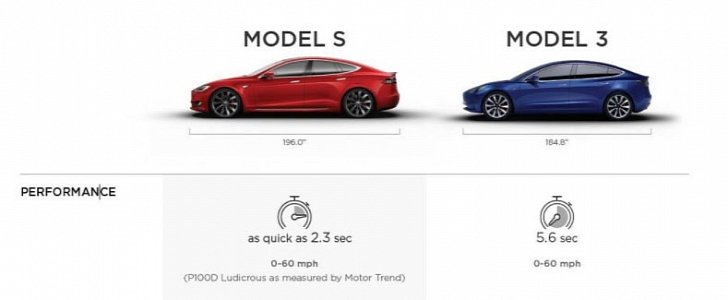It's probably a little presumptuous to think that Tesla only started to think about the real possibility of the Model 3 cannibalizing on the Model S customers after the smaller sedan was introduced to the world, but it's definitely when it started making clear distinctions between the two.
With a starting price that's almost half of that of the cheapest Model S and a maximum range that's almost the same (even though it hasn't been confirmed officially yet), there are a lot of reasons somebody might look at the existing EV and think "it might look better, but I look better too with $30,000 still in my pocket."
Well, things aren't as simple as that, and Tesla sure is keen on letting everyone know that. First of all, let's talk about Supercharger access. Back in January, the EV-maker announced all new cars would lose their free unlimited access to the Supercharger network and would have to pay for using them after the complimentary 400 kWh per year credit was consumed.
The decision was thought to be a way of making sure the Superchargers wouldn't get overcrowded once the Model 3s began rolling out 400,000 of them every year. On Monday, Tesla announced the return of the very attractive perk for the Model S and Model X owners, but it doesn't seem keen on extending it for the Model 3 as well.
The smaller sedan is due to begin production in just over a month, with a special event where the final production version will be unveiled to be held in July. We say "smaller," but what exactly is the difference compared to a Model S?
Thanks to a side-by-side comparison issued by Tesla, we now know. The Model 3's overall length is a little over 13-inches shorter, meaning interior room won't be at the same level as in the Model S.
On the other hand, the 3 does have a significantly smaller trunk/frunk combo (14 cubic feet - or 396 liters - compared to the 30 cubic feet - or 850 liters - in the S). Take into account that the Model S features those rear-facing jump seats that can accommodate two children, and the five adults it can carry are likely to find plenty of room to stretch their legs and elbows.
Another big difference between the two is going to be their performance potential. The 2.3 second 0-60 mph sprint of the P100D Model S will find no corresponded with the Model 3, with the quickest expected to finish the run in 5.6 seconds. At least according to this table because Musk referred to something in the four-seconds region when asked about it earlier.
Finally, there's the customization aspect. In its attempt to speed up production, Tesla cut short on the 1,500+ combinations available for the Model S to under 100 for the Model 3. All in all, we think there's enough here to make everyone who can afford a Model S think twice before deciding to downgrade to a Model 3, while still making the latter a very attractive choice.
Well, things aren't as simple as that, and Tesla sure is keen on letting everyone know that. First of all, let's talk about Supercharger access. Back in January, the EV-maker announced all new cars would lose their free unlimited access to the Supercharger network and would have to pay for using them after the complimentary 400 kWh per year credit was consumed.
The decision was thought to be a way of making sure the Superchargers wouldn't get overcrowded once the Model 3s began rolling out 400,000 of them every year. On Monday, Tesla announced the return of the very attractive perk for the Model S and Model X owners, but it doesn't seem keen on extending it for the Model 3 as well.
The smaller sedan is due to begin production in just over a month, with a special event where the final production version will be unveiled to be held in July. We say "smaller," but what exactly is the difference compared to a Model S?
Thanks to a side-by-side comparison issued by Tesla, we now know. The Model 3's overall length is a little over 13-inches shorter, meaning interior room won't be at the same level as in the Model S.
On the other hand, the 3 does have a significantly smaller trunk/frunk combo (14 cubic feet - or 396 liters - compared to the 30 cubic feet - or 850 liters - in the S). Take into account that the Model S features those rear-facing jump seats that can accommodate two children, and the five adults it can carry are likely to find plenty of room to stretch their legs and elbows.
Another big difference between the two is going to be their performance potential. The 2.3 second 0-60 mph sprint of the P100D Model S will find no corresponded with the Model 3, with the quickest expected to finish the run in 5.6 seconds. At least according to this table because Musk referred to something in the four-seconds region when asked about it earlier.
Finally, there's the customization aspect. In its attempt to speed up production, Tesla cut short on the 1,500+ combinations available for the Model S to under 100 for the Model 3. All in all, we think there's enough here to make everyone who can afford a Model S think twice before deciding to downgrade to a Model 3, while still making the latter a very attractive choice.

